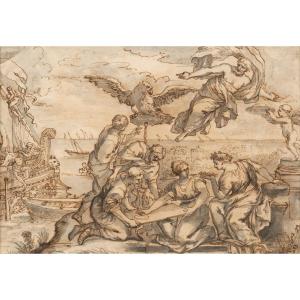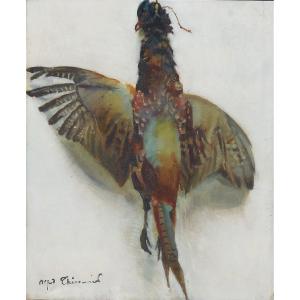Our composition, depicting an entablature richly garnished with food, invites the viewer to aesthetic enjoyment and inner questioning. In the foreground we see bread, an obvious symbol of the most basic food of humanity, it is also the spiritual food that Christ gives to men in the Eucharist, the liturgy evoking "the sacred bread of eternal life ". A beetle climbing on the loaf of bread announces the inevitable corruption of matter. Immediately behind, a römer filled with wine completes the Eucharistic symbolism. The artist demonstrates his talent by reflecting the source of light on the right edge of the finely worked glass, in this case a window whose frames can be seen. At the bottom of the composition, a Chinese porcelain cup accommodates snails. By leaving and returning its antennae sometimes, the gastropod evokes the notion of cyclic regeneration, death and rebirth. Thus, these three elements, bread, wine and snails, converge to evoke the idea of an eternal restart. The right of the composition is dominated by the presence of fruit. The pear, because of its flared shape at the bottom, evokes the silhouette of a fertile woman. Behind, the cut of apples delivers an even more obvious erotic meaning. Indeed, according to mythology, it was Dionysus who created this fruit to offer it to the goddess of love, Aphrodite. In our Christian West, the apple is the fruit of the Tree of Knowledge, symbolizing the temptation of original sin to which Adam and Eve succumbed. A few other fruits, nuts, strawberries and cherries balance the composition by filling in the gaps. A bee lands on one of these fruits. Also called "bird of Mary" or "bird of God", it is in the West the symbol of the soul. Thus the Germans spoke of Bienenweg (“path of the bees”) to designate the air in which the souls of the dead float. The refinement of this table, which reflects the standard of living of a wealthy man, acts as a memento mori for the viewer. The artist contrasts two groups of food, the one on the left having to do with Christ and the regeneration promised by the Eucharist, the one on the right relating to the universe of the flesh and sin. The representation of insects makes it possible to project man into this symbolic whole.
Our painting is presented in an elegant 17th century Emilian carved and gilded wooden frame.
Dimensions: 23.5 x 36 cm – 48 x 59 cm with frame
Georg Flegel (1566-1638), a native of Olmütz, spent his life in Frankfurt where he specialized in representations of fruit and flowers, collaborating in particular with the Valckenborch brothers, whose apprentice he was in the 1580s. His works, generally small in size, were intended to satisfy lovers of cabinet painting. He excels in the art of composing still lifes whose objects seem accidentally arranged and where the stag beetle appears recurrently. Only careful observation of the spectator will allow him to compare the symbols and thus to detect the message which presides over the organization chosen by the artist. These German artists, including Flegel, welcomed Antwerp innovations relating to still life beyond the Rhine. Nevertheless, Flegel stands out from the Flemish influence by depicting more static objects with an absence of ornamentation. He is today considered the leader of German still life painting.
Bibliography:
CHEVALIER Jean, Dictionary of symbols: myths, dreams, customs, gestures, shapes, figures, colors, numbers. Paris, Robert Laffont Jupiter, 1982. EBERT-SCHIFFERER Sybille, CANAL Denis-Armand, Still lifes, Paris, Citadelles & Mazenod, 1999.
GRIMM Claus, CANAL Denis-Armand, Flemish, Dutch and German still lives in the 17th and 18th centuries, Paris, Herscher, 1992.
KETELSTEN-VOLKHARDT Anne-Dore, Georg Flegel 1566-1638, Münche, Deutscher Kunstverlag, 2003.

























 Le Magazine de PROANTIC
Le Magazine de PROANTIC TRÉSORS Magazine
TRÉSORS Magazine Rivista Artiquariato
Rivista Artiquariato
